
There was a time when the IT world resembled a slow-moving river, often clogged with the weeds of complexity and long project delivery times. Most solutions felt like ordering a gourmet meal and waiting forever, only to receive a cold sandwich. Admittedly, it was a period of painstaking challenges and stifled innovation.
However, the advent of Microsoft Power BI marked a pivotal turning point, moving IT from the slow-paced river of complexities to a fast-flowing stream of possibilities. With machine learning models, artificial intelligence, and new data engineering breakthroughs, harnessing the power of data has never been more possible. Today, as we stand on the brink of another data transformation revolution, we can’t help but gaze in awe at the latest marvel: Microsoft Fabric Data Analytics.
Harnessing the speed and agility of Business User Tools with the integrity of a high-end Analytics and AI platform has unleashed a paradigm shift for data scientists and business intelligence professionals alike. Think of merging the dexterity of a cat with the might of an ox, and you get a glimpse of this technological marvel. Microsoft Fabric Data Analytics leverages this combination to allow businesses to process and analyze large volumes of organizational data without hiccups.
There are countless valuable ideas that we can now pursue that were previously out of reach and inaccessible to the business leaders who need them most.
What Is Microsoft Fabric?
Think of Microsoft Fabric as a super-charged data analysis platform. It’s like the data wizard that helps businesses effortlessly collect, store, analyze, visualize, act on and transform data — vast amounts of data. Microsoft Fabric is a sophisticated and versatile solution that seamlessly combines various Data Analytics and AI services, leveraging a powerful architecture and user-friendly interfaces.
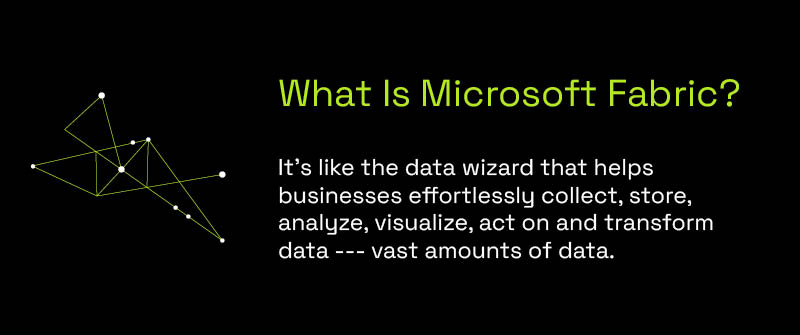
For better understanding, let’s see things differently.
Imagine the biggest buffet you’ve ever seen. Microsoft Fabric is similar to that but for Data Analytics and AI. It’s a colossal platform that fuses Dashboards, Data Storage, Movement, Machine Learning, and Team Collaboration into one seamless experience. It’s all served up with a big helping of user-friendly features and garnished with a focus on collaboration.
The brilliance of Microsoft Fabric is its inclusive nature. Microsoft wasn’t content with creating a tool just for tech wizards; no, they went above and beyond. Whether you’re a ‘Business User/Citizen Developer’ or a ‘Code First Developer’, Microsoft Fabric has something for everyone. You might be wondering, can an analyst using a basic tool like Power Query and a data scientist using complex algorithms share the same space? With Fabric, they’re not only sharing a room, they’re dancing the tango together.
To cap it off, Microsoft Fabric isn’t just your regular analytics tool; it’s a powerhouse that can work for both startups and giant corporations. It has everything you need to take raw data and turn it into gold by providing valuable insights that can drive smart decisions in today’s fast-paced world.
*To learn more about P3’s take on Fabric, read our complete Microsoft Fabric review.
What Is the Cost of Microsoft Fabric?
Let’s discuss finances. Imagine yourself shopping for a new car. You wouldn’t buy a truck when you need a compact car, right? The same goes with Fabric; you buy according to your needs. Microsoft Fabric Capacities are akin to the size and model of a car. They vary in size, and you should pick one that aligns with your organization’s needs. Fabric Capacity refers to the platform’s ability to handle data efficiently. Capacity is determined by factors such as data volume, complexity of analytics, and user load.
There are two payment models available. You can choose between a flexible Pay-as-you-Go model or Reserved Instances. The former offers flexibility, allowing you to adapt to the ever-changing needs of your organization. It’s great for fluctuating data volumes or when you’re uncertain about long-term requirements. The latter involves a more extended commitment, but in return, you get favorable rates. Ideal for established businesses with predictable data requirements. So, evaluate your requirements, set your budget, and drive away with the perfect solution.
See the table below for a detailed look at the Fabric Capacity pricing structure.
| SKU | Capacity unit (CU) | Pay-as-you-go (hourly) | Pay-as-you-go (monthly) |
| F 2 | 2 | $0.36 | $262.80 |
| F 4 | 4 | $0.72 | $525.60 |
| F 8 | 8 | $1.44 | $1,051.20 |
| F 16 | 16 | $2.88 | $2,102.40 |
| F 32 | 32 | $5.76 | $4,204.80 |
| F 64 | 64 | $11.52 | $8,409.60 |
| F 128 | 128 | $23.04 | $16,819.20 |
| F 256 | 256 | $46.08 | $33,638.40 |
| F 512 | 512 | $92.16 | $67,276.80 |
| F 1024 | 1024 | $184.32 | $134,553.60 |
| F 2048 | 2048 | $368.64 | $269,107.20 |
What Is Microsoft Fabric Used for in Data Integration and Data Engineering?
Microsoft Fabric wears many hats. It’s not just another addition to the tech universe; it’s a multi-dimensional platform with the main purpose of facilitating the seamless processing and analysis of vast volumes of data in real time, thereby empowering organizations to enhance their operational efficiency.
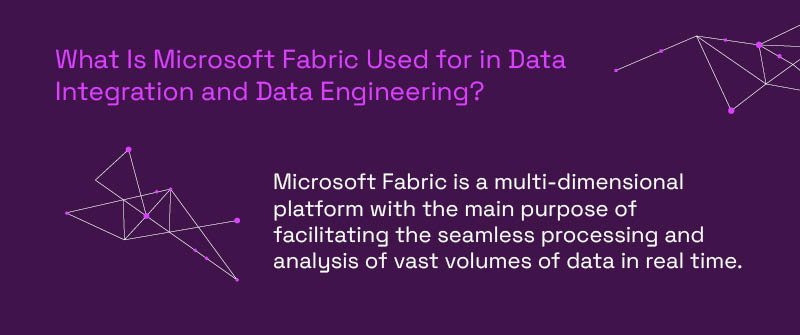
Let’s delve into its multifaceted functionalities:
Analytics Services including Data Models and Dashboards
Visualization is the key to understanding. In a world inundated with raw data, Microsoft Fabric helps turn these numbers into insightful, visual stories. Businesses can design customized dashboards through its advanced modeling capabilities. This is like turning a complex novel into an easily digestible comic book, ensuring everyone understands the narrative.
Self-Service Data Exploration
Curiosity led us to discover fire, invent the wheel, and reach the moon. Fabric encourages this innate human curiosity. Business users can dive into datasets, ask questions, and unearth insights without always relying on IT or data professionals. It’s like handing you a magnifying glass to examine the universe of your data closely.
Data Ingestion, Transformation, and Storage
Picture a maestro orchestrating a symphony. This is the essence of Fabric’s capability in data management. It can gracefully ingest data from multiple sources, transform it into insightful structures, and then securely store it. This ensures your data is not just dumped somewhere but is carefully organized, much like the notes of a harmonious melody. Data stored in this way is much easier to sort through and interpret.
Machine Learning Applications
The future is AI-driven, and Fabric is ahead in this game. Incorporating machine learning it allows businesses and data engineers to predict trends, understand customer behavior, and automate routine tasks. It’s the crystal ball, coupled with a digital assistant, making sure you’re always ahead of the curve.
Data Activation Capabilities
Microsoft Fabric is not just about handling massive sets of data. One of its most pivotal features is the Data Activator, a powerhouse in itself. Microsoft Fabric’s Data Activator is the linchpin that transforms raw data into actionable insights, centralizing disparate sources into a unified view. Recognizing the importance of maintaining the integrity and security of data, it comes armed with robust governance tools, ensuring that your data remains uncompromised and trustworthy. Furthermore, with automation at its core, it streamlines data tasks, eliminates redundancies, and champions real-time activation. In a dynamic business landscape, Data Activator empowers organizations with timely insights, enabling them to stay consistently ahead of the curve.
Real-time Collaboration and Sharing
In the age of remote working and global teams, collaboration becomes the backbone of any successful project. Fabric isn’t just a tool but a collaborative platform. Team members can simultaneously work on projects, share insights, and brainstorm in real time. It’s like having a digital conference room where data is the primary agenda.
Integration with External Tools and Platforms
Businesses use a myriad of tools and platforms. Microsoft Fabric acknowledges this diversity and ensures it doesn’t stay isolated. Just as a chameleon blends effortlessly into its surroundings, Microsoft Fabric is adept at integrating with your existing technological landscape. It’s built on the principle of compatibility, ensuring that transitions and data migrations are as smooth as a well-rehearsed dance. It can seamlessly integrate with various external tools, ensuring you don’t have to juggle between applications. It’s the glue that can hold your digital ecosystem together.
By wrapping all these functionalities into one cohesive platform, Microsoft Fabric ensures that businesses have the power to harness data like never before.
What Is the Future of Microsoft Fabric?
If Fabric were a crystal ball, its future would be brighter than a supernova. Have you ever thought about where the ever-evolving world of technology is headed? Well, with Microsoft Fabric, we might just have a compelling teaser for the next chapter. Picture this: barriers to analytics and AI projects crumble like dominos. It’s not a far-fetched daydream; it’s the reality that Microsoft Fabric is scripting.
Fabric aims to transform intricate tasks into child’s play. Think of it as turning a month-long project into a day’s work. With tools like Co-Pilot, it’s not just about speed but also making tasks user-friendly. Microsoft’s vision is to have AI in Fabric as a handy assistant, predicting trends and simplifying data.
The true potential of Microsoft Fabric lies in the solutions to challenges we haven’t even faced yet. In the same way smartphones unpredictably changed our world two decades ago, Fabric might redefine business operations, analytics, and AI in ways we can’t yet fathom. The future isn’t just bright with Fabric; it’s transformative.
How Does Microsoft Fabric Ensure Data Security?
In today’s digital age, likening data to gold isn’t an exaggeration. As we generate and store more data than ever before, its protection becomes crucial. Microsoft Fabric emerges as a guardian, akin to a state-of-the-art vault designed to protect your invaluable assets. It not only wards off potential breaches with multi-layered encryptions but also employs sophisticated authentication protocols. This ensures that your data isn’t just shielded from external threats, but only those with the right credentials are granted access. With Microsoft Fabric, you can be assured your data’s sanctity is maintained, letting you focus on harnessing its potential without fretting over security loopholes.
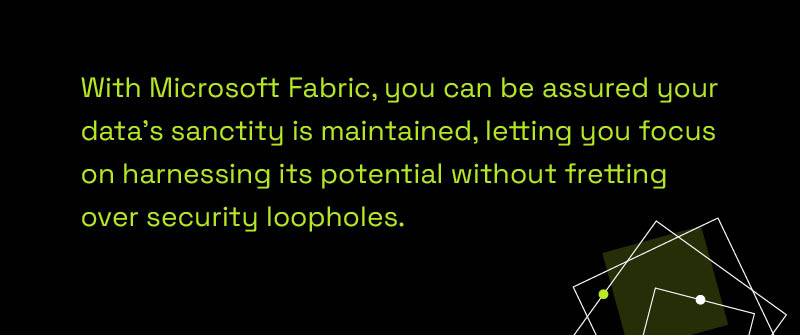
How Does Microsoft Fabric Documentation Work?
Remember the times when you’d assemble a toy, and the instruction manual seemed like it was for a spaceship? With Microsoft Fabric, you won’t feel like you’re deciphering alien technology. The documentation is integrated seamlessly, always at your service. So, whether you’re building a toy car or a spaceship, you’ve got the perfect guide by your side. The documentation of Microsoft Fabric is designed with you, the user, at its heart. It doesn’t just inform; it guides, educates, and simplifies. Let’s take a quick glance.
- Integrated Seamlessly: Unlike standalone documentation, which can feel disjointed, Microsoft Fabric is integrated right within the platform. This ensures that as you navigate through various features, contextual help is just a click away. It’s like having a tech-savvy friend right beside you, offering tips and tricks as you explore.
- User-Centric Design: The Fabric documentation isn’t a monotonous tech manual. It’s curated to suit everyone, from beginners to experts. Visual aids, flowcharts, and interactive modules ensure that you’re not just reading but truly understanding.
- Regularly Updated: In the fast-evolving world of tech, yesterday’s information can be obsolete today. Microsoft ensures that Fabric’s documentation is continuously updated. So, you’re always equipped with the latest know-how, ready to harness the platform’s full potential.
- Community Contributions: The beauty of Fabric’s documentation is that it’s not just crafted by Microsoft’s experts but is also enriched by the community. This means if a user discovers a novel solution or a handy workaround, they can contribute, making the documentation a collective reservoir of insights. Picture it as a bustling town square where thinkers, innovators, and creators converge to share, collaborate, and inspire.
Whether you’re seeking a solution to a tricky problem, looking for innovative ways to harness Fabric’s potential, or just looking to share your success story, this community is always abuzz. With forums, webinars, and collaborative projects, it’s a thriving ecosystem where ideas grow; challenges are conquered, and every voice, no matter how new or experienced, finds resonance. Here, every question is an opportunity for learning, and every shared solution adds to the collective wisdom.
- Helpful Tips and Best Practices: Along with “how to” instructions, the literature also includes recommended best practices. As a result, you won’t only learn to complete a task; you’ll also pick up suggestions for doing it efficiently.
- Search and Index Features: Time is of the essence. With the search functionality and a well-organized index, you can quickly jump to the section you need without wading through pages of unrelated content.
In essence, with Microsoft Fabric’s documentation, you’re not just getting a rulebook; you’re getting a dynamic playbook. Whether you’re aiming to construct a simple data model (akin to that toy car) or architecting a complex AI-driven analytics solution (our metaphorical spaceship), you’ve got a guide that’s detailed, accessible, and always up to date. So, dive in with confidence, knowing you’re well-equipped to build, innovate, and excel.
Microsoft Fabric vs. Azure – Which Is Best For Your Organization’s Needs?
Azure is Microsoft’s vast cloud platform, offering a diverse suite of in-depth services ranging from databases to AI tools. Think of it as a sprawling library where you can delve into specific subjects. On the other hand, Microsoft Fabric is like a concise encyclopedia. It combines the essence of technologies like Power BI, Azure Synapse Analytics, and Azure Machine Learning into a unified, user-friendly platform.
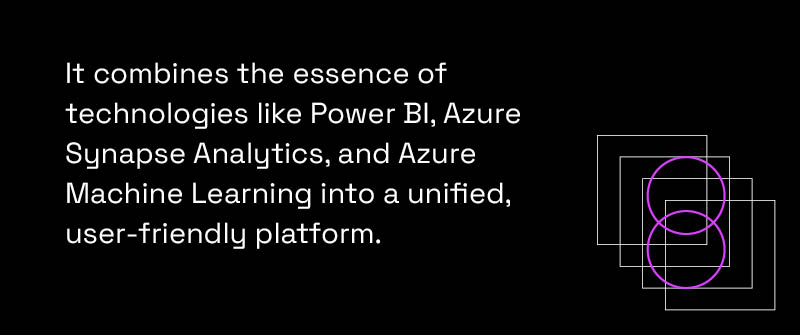
Nuanced Situations Favoring Azure
There are specific scenarios where the expansive toolkit of Azure proves advantageous:
- Complex Infrastructure Needs: If your project demands intricate virtual networking or a multifaceted deployment strategy, Azure’s comprehensive suite caters to those complexities.
- Hybrid Solutions: For businesses operating both on-premises and in the cloud, Azure’s hybrid capabilities provide a seamless bridge.
- Advanced AI Projects: While Fabric offers robust AI tools, certain advanced AI or machine learning projects might benefit from Azure’s specialized Machine Learning Studio.
Similarities with Synapse Data, AzureML, and PowerBI
- Data Integration: Both Azure services (like Synapse data science) and Fabric facilitate smooth data integration and analytics.
- Machine Learning: AzureML’s deep machine learning tools find parallels in Fabric’s AI capabilities, albeit in a more user-friendly manner in Fabric.
- Visualization: PowerBI’s strength in data visualization is mirrored in Fabric, providing intuitive dashboards and reports.
How to Choose Between Azure and Fabric?
The decision between Azure and Fabric boils down to your specific needs: depth vs. efficiency. While both platforms have overlapping capabilities, their use cases can differ based on project intricacy and user expertise. If you’re keen on detailed customization, Azure’s your pick. But if you want streamlined efficiency without diving deep into complexities, Microsoft Fabric is the way to go. The choice depends on your needs.
P3 Adaptive plays the role of your trusted guide. We analyze your business needs, assess the complexity of your projects, and help you navigate the choice. Our experts can pinpoint when the vastness of Azure is essential or when the simplicity of Fabric would suffice. With us, you’re not just choosing a platform; you’re crafting a bespoke solution.
How to Use Microsoft Fabric for Data Analytics?
Integrating Microsoft Fabric into your data analytics strategy is like adopting a super smart pet. It has the capabilities, but you need to guide it initially. It’s about understanding its potential, recognizing its pace, and channeling its energy in the right direction.
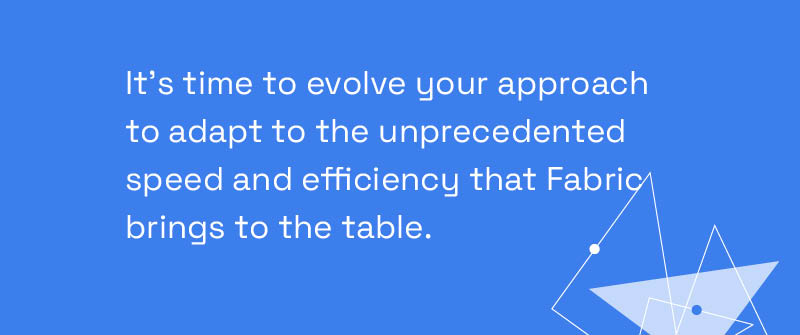
With Fabric by your side, your journey from conceptualization to realization becomes shorter and smoother. It’s like having a pet that doesn’t just fetch the ball but predicts where you’ll throw it next. It’s time to evolve your approach to adapt to the unprecedented speed and efficiency that Fabric brings to the table. So, how should your teams operate in this new paradigm?
Evolving Your Approach
- Speed and Tempo: The world is moving fast, and so should your analytics. Fabric introduces a pace that’s exhilarating, empowering your teams to think, innovate, and execute at the speed of thought. Gone are the days of lengthy project timelines. With Fabric, you’re not just keeping pace; you’re setting the tempo.
- Tailored Projects: While big, audacious projects have their thrill, Fabric encourages you to be nimble. Break those large goals into swift, actionable tasks. This modular approach ensures momentum is sustained and each phase is executed flawlessly.
Empowering Your Teams
- Rapid Prototyping: Envisioning an innovative concept? Fabric’s capabilities mean you can transition from idea to prototype in under five days. It’s about turning dreams into tangible realities at record speed.
- The Ideal Launchpad: Shift from the limitations of traditional local storage (remember those bulky CSVs?) to an expansive, agile environment. Fabric’s Lakehouse model seamlessly marries the flexibility of data lakes with the structure of databases, offering the best of both worlds.
- Iterate, Refine, Deploy: In the dynamic world of analytics, adaptability is key. Fabric ensures your teams can prototype faster, iterate and refine solutions with agility, and swiftly roll out finalized models to production.
To encapsulate, Microsoft Fabric is more than just a tool; it’s a paradigm shift. It encourages businesses to think bigger, act faster, and deliver excellence in every facet of data analytics. With Fabric, you’re not merely participating in the data revolution; you’re spearheading it.
How P3 Adaptive Helps You Get the Most Out of Your Data with Microsoft Fabric Data Analytics Services
Let’s say you’ve bought the latest high-tech camera – Microsoft Fabric. P3 Adaptive is like that professional photographer friend who ensures you don’t just click pictures but capture memories. With our expertise, the complex functionalities become accessible, and the results extraordinary. From helping you set up the tripod (laying the groundwork) to adjusting the focus (fine-tuning your objectives), we ensure every shot is picture-perfect!
Your Journey, Our Expertise
Every expedition needs a roadmap. We don’t hand you a generic one; we craft it with you, aligning with your business needs and ensuring every milestone matters. From gauging your readiness for Fabric to plotting the waypoints for maximum impact, we’re by your side.
Real People, Real Solutions
We aren’t just experts wielding tech tools; we’re passionate individuals dedicated to bringing your vision to life. Behind our tech expertise is a heart that beats in sync with your aspirations. We understand the highs, the lows, and the crescendos of every project. And we ensure that with Fabric, your performance isn’t just memorable, it’s legendary.
Embarking on the Microsoft Fabric journey? Let’s ensure it’s not just a trip but an expedition of discovery and success. Connect with our data engineers today and dive deeper with our exclusive webinar, where we unroll the map, guide you through the terrains, and ensure you reach the summit!
Get in touch with a P3 team member